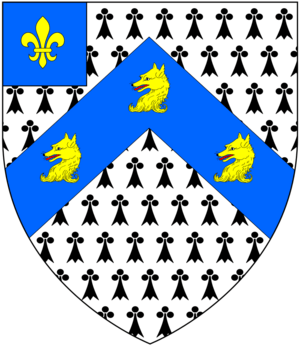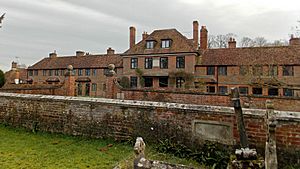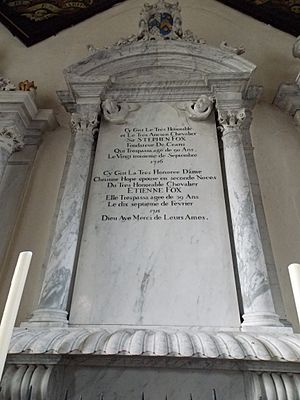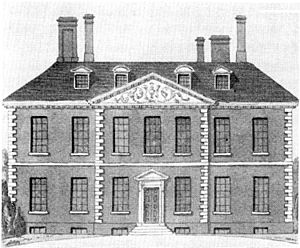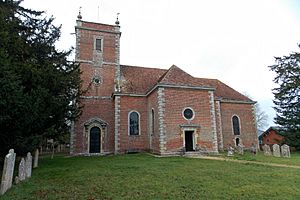Stephen Fox facts for kids
Quick facts for kids
Sir Stephen Fox
|
|
|---|---|
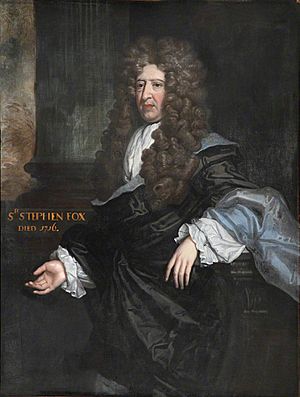
Portrait by John James Baker at the Royal Hospital Chelsea
|
|
| Personal details | |
| Born | 27 March 1627 Farley, Wiltshire |
| Died | 28 October 1716 (aged 89) |
| Nationality | British |
| Spouses | Elizabeth Whittle Christiana Hope |
| Children | 14 children including Stephen Fox-Strangways, 1st Earl of Ilchester Henry Fox, 1st Baron Holland |
Sir Stephen Fox (born 27 March 1627 – died 28 October 1716) was a very important person in the royal court of King Charles II. He started from a simple background and became known as the "richest commoner" (a person who is not a noble) in England, Scotland, and Ireland.
He made most of his money as the Paymaster-General of His Majesty's Forces. This was a new job where he managed the money for the army. He held this role twice, from 1661 to 1676 and again from 1679 to 1680. Sir Stephen Fox was also the main person who came up with the idea for the Royal Hospital Chelsea, a famous home for old soldiers, and he gave a lot of his own money to help build it.
Contents
Stephen Fox's Early Life
Stephen Fox was born in Farley, Wiltshire. His father, William Fox, was a farmer. His mother was Margaret Pavy. Stephen had an older brother, John, who worked for King Charles II. John helped Stephen get his first job at the royal court, where he was a "play-fellow" for the royal children.
Stephen started as a choirboy at Salisbury Cathedral when he was young. Someone once described him as "a poor boy from the choir of Salisbury," showing how he started with very little.
His Amazing Career Journey
When he was 15, Stephen started working for a noble family. He was even with the royal army during the Battle of Worcester. After King Charles II had to leave England, Stephen went with him to other countries. He became very good at managing the royal family's money while they were in exile (living away from their home country).
Because he was so good with money, the king trusted him a lot. Stephen even helped the king return to power in England. When the king came back, Stephen was rewarded with important jobs, including First Clerk of the Green Cloth and Paymaster of the Forces.
Becoming the Paymaster of the Forces
After King Charles II returned to the throne, he needed a way to pay his new army. This was a big problem, but Stephen Fox was seen as a "financial wizard" who could solve it. He had already managed the king's money successfully when they were in exile.
So, the king created the new job of Paymaster of the Forces, and Stephen Fox was the first person to do it. His office was in a building called Horseguards in Whitehall. Stephen was able to get loans from rich people and banks in London because everyone trusted him. This helped pay the soldiers.
To thank him for taking on such big risks, Stephen was allowed to keep some of the money he managed. For example, he earned a small percentage on the money he borrowed and repaid. He also received a "poundage," which meant he kept a small amount (like one shilling for every pound) from the army's pay. This was supposed to cover his costs, but it also made him very rich. This job alone brought him about £7,000 a year, which was a huge amount of money back then! He held this important job for 15 years.
Stephen Fox's Political Life
In 1661, Stephen Fox became a Member of Parliament (MP) for Salisbury. In 1665, he was made a knight, so he became "Sir Stephen Fox." He continued to be an MP for different areas, including Westminster and Cricklade.
He also became a Commissioner of the Treasury, helping to manage the country's money for over 20 years under three different kings. In 1672, he bought a large estate called Redlynch in Somerset, where he later built a new house.
King James II offered Sir Stephen Fox a special title (a peerage), but only if he changed his religion. Sir Stephen refused, but he was still allowed to keep his important jobs. Even though he was loyal to the king, he sometimes disagreed with him, like when he spoke against having a large standing army.
When King James II left England during the Glorious Revolution, Sir Stephen Fox supported the new King William III, who let him keep his positions. Sir Stephen Fox was a very respected public servant. He became rich while working for the country, but no one ever thought he was dishonest.
He is especially remembered for helping to create the Royal Hospital Chelsea, a famous home for retired soldiers. He gave £13,000 of his own money to this important project.
Sir Stephen Fox's Family Life
Sir Stephen Fox was married twice and had many children.
- His first wife was Elizabeth Whittle. They married in 1651. They had seven sons, but sadly, all of them died before their father. They also had three daughters.
- One of his sons, Charles Fox, also became a Member of Parliament for Salisbury and even followed in his father's footsteps as Paymaster of the Forces for several kings and queens.
- His second wife was Christiana Hope. They married in 1703 when Sir Stephen was 76 years old. With Christiana, he had two sons and two daughters.
- His eldest son from this marriage was Stephen Fox-Strangways, 1st Earl of Ilchester. His family still holds the title of Earl of Ilchester today.
- His second son was Henry Fox, 1st Baron Holland, who also became a very important politician. Henry's son, Charles James Fox, became a famous statesman.
Homes and Estates
Sir Stephen Fox owned several impressive homes and estates:
- Farley, Wiltshire: This was his family's original home, and it's where he was buried.
- Plaitford, Hampshire: He bought this estate in 1679.
- Chiswick, Middlesex: West of London, he built a magnificent house here between 1682 and 1686. It was so grand that one writer called it "the flower of all the private gentlemen's palaces in England." King William III especially loved the gardens.
- Redlynch, Somerset: He bought this estate in 1672 and later built a new house there between 1708 and 1709.
- Palace of Whitehall, Westminster: He rebuilt his own living quarters here before 1677.
Other Buildings He Helped Create
Sir Stephen Fox was also involved in building several important structures:
- All Saints Church, Farley: He built this church between 1688 and 1690. It was designed by the famous architect Sir Christopher Wren. The church is where Sir Stephen and many of his family members are buried.
- Fox's Hospital, Farley: This was an almshouse (a home for poor people) with a schoolroom, built between 1688 and 1690. It was for six poor women and had a school with a clergyman as the master. This charity still helps people today.
- Royal Hospital Chelsea: As mentioned, he gave a large sum of £13,000 to help build this famous hospital for soldiers, which was also designed by Sir Christopher Wren.
- Manor Farm House in Chiswick: In 1698, he built this house. Some of its original walls still exist today.
His Final Years
Sir Stephen Fox passed away on 28 October 1716, at the age of 89, at his home in Chiswick. He was buried in the church he rebuilt in Farley. He left behind a huge amount of money, showing just how successful he had been in his life.


